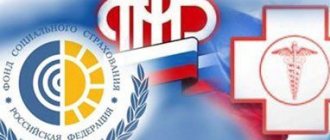Many companies are striving to switch to preferential tax regimes, for example, to “simplified taxation”. And it’s not surprising, since under the simplified system, VAT, income tax and personal income tax (for individual entrepreneurs) are not charged.
Knowledge of the law will help you reduce your organization's tax burden. According to Article 346.21 of the Tax Code, the accrued tax can be reduced. To do this, it is necessary to deduct insurance contributions paid for employees from the calculated tax. However, there is a limit.
The tax cannot be reduced by more than 50%. And if an individual entrepreneur does not have employees, and he decides to take advantage of the tax reduction, then he can reduce it to zero.
In most cases, organizations bear a high tax burden due to ignorance of tax legislation and applicable benefits. If your organization does not have a specialist with the necessary training on staff, you can request advice from a professional.
What is a simplified tax system
In total, there are 5 systems in Russia: general regime (OSNO), simplified regime (USN), UTII and Unified Agricultural Tax, patent (for individual entrepreneurs). An organization has freedom of choice, but in order to switch to a specific system, it must meet a number of criteria.
For a simplified system, these criteria are:
- An organization operating under the simplified tax system should not have branches, but representative offices are allowed. The difference between a branch and a representative office is in the scope of functions. A representative office can represent the interests of the organization, conduct negotiations, conclude contracts, etc. A branch is an enterprise that is similar in functionality to the head office but is located in a different location;
- the number of employees on staff is no more than 100 people;
- for JSCs and LLCs wishing to switch to the simplified tax system, income should not exceed 112.5 million rubles for three quarters of the previous year. There is no such restriction for individual entrepreneurs. Total annual income no more than 150 million rubles;
- equity participation in the authorized (or share) capital is allowed in the amount of no more than 25%;
- the residual value of fixed assets for applying the simplified tax system should be no more than 150 million rubles.
If an organization meets the above criteria, then it can apply a simplified tax regime. However, these limits also apply to companies that already use the simplified system.
It is necessary to constantly monitor compliance with restrictions. Also, Article 346.12 of the Tax Code provides a complete list of types of organizations that cannot use the simplified regime, for example, pawnshops, credit organizations, law firms and notary offices.
Deductions to secure a claim - what is it and how are they determined?
In the event of the formation of one or several long-term (more than 3-6 months) debts, an interested individual or organization, a representative of a government agency, can file an application with the court demanding the return of financial resources that legally belong to them.
What debts can be subject to legal proceedings:
- Loans from banks and microloans from microfinance organizations.
- Alimony for minor children and elderly relatives.
- Fines, including from the traffic police.
- Late utility bills with accrued penalties.
- Private agreements with individuals, confirmed by receipts or sales agreement.
If the claim is approved, a verdict is issued to transfer the case to the FSSP (Federal Bailiff Service), where enforcement proceedings are opened. The SPI (executor) forms a sheet in which the rules and requirements are noted according to which this money can be returned - this could be:
Bankruptcy of individuals
from 5000 rub/month
Read more
Services of a credit lawyer
from 3000 rubles
Read more
Legal assistance to debtors
from 3000 rubles
more
Write-off of loan debts
from 5000 rub/month
More details
- voluntary payment of debt;
- withdrawal of funds held in deposit accounts and deposits;
- seizure of a salary card (or any other card to which income is transferred, except social payments);
- confiscation of property (real estate, cars, household appliances, etc.) for the purpose of sale at auction.
Most often, the bailiff stops at deductions according to the writ of execution. This is possible in cases where the debtor has official income, which he receives on a bank card. This assumes that a person will not receive the entire salary, but only part of it, the rest will be spent on gradually paying off the debt.
The percentage of penalties is determined at the time of drawing up the document according to which the bailiffs work. Since it, or rather a copy of it, is sent to the debtor by mail for review, you can see in advance how much will be spent on repaying the debt, which means you can immediately think through a strategy on how to reduce the percentage of withholding under the writ of execution. This way, you can predict your budget in advance and collect supporting documents that will allow you to insist on a reduction in payments.
Determining the amount of penalties depends on several parameters:
- the amount of debt in general;
- the amount of monthly income;
- number of family members, dependents and additional factors.
As a rule, the FSSP often does not take into account all the nuances of marital status, so you have to collect documents confirming them. Therefore, the most common initial standard rate is 50% deducted from wages.
Then the document with the corresponding order is sent either to the bank or to the secretary (or manager) at the place of work. Thus, the person making the accrual immediately transfers half of the salary (pension) to the details of the bailiffs, and leaves the rest, as usual, to the employee.
Tax base of organizations of the simplified tax system
There are two options for determining the object of taxation under the simplified tax system. The differences lie in the tax base and tax rate.
- STS 6% (object “income”). A rate of 6% is charged only on the organization’s income, namely all revenue excluding production costs. Subjects of the federation can independently determine the tax rate from 1% to 6%. It will depend on the type of activity of the organization.
- STS 15% (object “income-expenses”). In this case, all expenses must be deducted from revenue. The tax rate of 15% is multiplied by the calculated amount. It must be remembered that there is a list of expenses that are not included in the calculation of the tax base. The list is determined by tax legislation in paragraph 1 of Art. 346.16 of the Internal Revenue Code.
If your organization’s expenses account for more than 60% of total revenue, then it is more profitable to use the 15% “income-expenses” simplified tax system option. If expenses are less than 60%, then you will not receive a tax benefit, and then you can charge tax on the “income” base.
Thus, depending on the tax base, the simplified regime rate can be 6% or 15%. In addition, taxes common to all taxation systems must be paid. These include: property taxes and insurance premiums for employees.
Reduction rules
Based on Article 346.21 of the Tax Code, payers who have chosen the simplified tax system can reduce the amount of taxes paid for a certain reporting period by the amount of insurance payments. These include fixed and additional payments to the Pension Fund of the Russian Federation, insurance for temporary working capacity or for the period of maternity. This list may also include insurance that covers damage from occupational diseases or accidents that occur at the company.
The payers of all the above types of contributions are considered to be several groups of persons and organizations:
- Persons making payments to individuals. In other words, employers who pay wages to their employees and make other types of payments.
- Individual entrepreneurs, lawyers and notary offices that do not employ employees and do not pay any payments to other individuals. But it is obligatory for them to submit contributions to the state budget for themselves.
But even here there are several different rules for deducting expenses that reduce the amount of the simplified tax system “6 percent” depending on the actual object. For entrepreneurs using the “Income” scheme, it is the tax itself that needs to be reduced. But those who applied “Income minus expenses” will not have to recalculate anything. Insurance premiums will be deducted from the tax base initially.
On the simplified tax system
There is a rule that indicates for the simplified tax system for individual entrepreneurs “Income 6 percent” by what the tax is reduced and under what conditions this can be done:
- Payments are made during the reporting period in which the tax amount needs to be reduced.
- Contributions have been paid to the extent required. And if the tax was assessed in amounts exceeding the optimal indicators, the excess can be transferred to account for debts.
- It is possible to reduce taxes only after adopting a simplified taxation system. If the debt is repaid during the period in which another system was used, it will no longer be possible to carry out a similar procedure.
Important! The tax deduction includes all funds paid according to the general rules, including income exceeding the mark of 300,000 rubles.
On UTII
In 2020, the reduction of UTII for insurance premiums is carried out practically according to the same principle as that applied under the simplified taxation system. Previously, for this system, individual entrepreneurs were allowed to reduce taxes only if there were employees on staff. Now, entrepreneurs may well reduce the quarterly tax on the total amount of insurance premiums paid for themselves.
Methods for reducing taxes according to the simplified tax system
Tax reduction methods are also divided into two groups. Organizations operating under the simplified tax system of 6% can reduce the tax by the amount of insurance premiums transferred to the budget for employees. The tax reduction limit is set at 50%. If the organization does not have personnel, then the tax can be reduced on all insurance contributions paid. This right is reflected in Article 346.21 of the Tax Code of the Russian Federation.
What insurance premiums do organizations pay for employees?
- OPS. Contributions to the pension fund are 22%.
- Compulsory social insurance (OSI) for disability and maternity. This type of social contribution is 2.9%.
- Compulsory medical insurance. Compulsory health insurance costs 5.1% of an employee’s salary.
At the same time, if contributions are paid by an individual entrepreneur, then a fixed amount must be paid. As of 2020, the amount of individual entrepreneur contributions to the pension fund is 29,354 rubles, for compulsory health insurance - 6,884 rubles. Also, individual entrepreneurs are required to pay 1% of annual income from an amount exceeding 300,000 rubles.
To reduce the tax, it is necessary to subtract the amount of insurance premiums for the current period from the calculated value. Let's look at a small example.
IP Evdokimova I.I. uses simplified tax system 6%. For the first 6 months of the tax period, income amounted to 1.5 million rubles. Insurance premiums for employees in the amount of 70,000 rubles are paid in advance payments quarterly. Thus, the first advance payment of the year for the first quarter amounted to 20,000 rubles. For the first two quarters, the tax according to the simplified tax system is: 1,500,000 * 6% = 90,000 rubles.
You can reduce the tax for this period by 45,000 rubles (90,000*50%). Therefore, the balance of tax payable minus the first advance payment is = 90,000 - 45,000 - 20,000 = 25,000 rubles. If an individual entrepreneur had not reduced the tax, the overpayment would have been 45,000 rubles.
If an organization operates under the simplified tax system of 15%, then the tax can be reduced by reducing the tax base. Since the tax is charged on the “income-expenses” object, the base can be reduced either by increasing expenses or decreasing income.
Most often they resort to increasing costs. The list of expenses that can reduce the tax base is reflected in Art. 346.36 Tax Code of the Russian Federation. These include: expenses for fixed assets, for the acquisition or creation of intangible assets, for scientific research, retraining of personnel, etc.
The single tax under “simplified taxation” is calculated based on the results of economic activity for the year. According to the simplified tax system of 15%, two payments must be calculated:
- Regular tax is 15%. In this case, the tax is determined by the formula: (Income-Expenses)*15%;
- Minimum tax of 1% of income. It is calculated using the formula: (Income from sales + Non-operating income) * 1%.
If the tax calculated at a rate of 15% turns out to be less than the minimum, then the minimum tax is subject to accrual.
Payment of taxes using the simplified tax system 6%
By choosing the simplified tax system “Income” you will get rid of the need to pay and report on the following taxes:
- income tax for legal entities and personal income tax for individual entrepreneurs;
- value added tax;
- property tax
Sometimes these taxes need to be paid. For example, VAT is paid when importing goods from abroad, regardless of the tax regime. And if your property is subject to property tax based on cadastral value, then you will have to pay that too. All exceptions are listed in Art. 346.11 Tax Code of the Russian Federation.
Transport and land taxes are retained if there is property.
Individual entrepreneurs are annually required to pay insurance premiums “for themselves” - 40,874 rubles plus 1% of turnover over 300 thousand rubles. In addition, simplifiers should not forget about the annual declaration under the simplified tax system and reports for employees. LLCs also submit financial statements.
Bill No. 875583-7 is under consideration. If it comes into force, then if you have an online cash register, you will not have to submit an annual tax return. The amount of tax and advance payments will be calculated automatically, and the tax office will issue receipts for payment. This mode is called “STS-online”
In simplified form, you need to record all your income in the book of income and expenses (KUDiR). There is no need to submit it to the Federal Tax Service at a certain frequency. KUDiR is handed over to tax authorities only upon their request.
Deadlines and reporting are standard for the simplified system. Read more about this in the article “What is the simplified tax system.”
Briefly about the main thing
Every organization strives to increase its net profit. However, ignorance of tax benefits often leads to a high fiscal burden.
Organizations operating under the simplified tax system of 6% are entitled to a tax reduction of 50%. This occurs by subtracting insurance premiums paid for employees from company income.
Organizations operating under the simplified tax system of 15% can reduce tax either by reducing income or by increasing expenses. There are many legal ways to reduce your tax base. This is part of the company's tax optimization and should be carried out by a specialist with in-depth knowledge of tax legislation.
Sources:
Chapter 26.2. SIMPLIFIED TAX SYSTEM, Tax Code.
What conditions to comply with?
Please note that the bank may withhold a commission from the transferred funds. Then the individual entrepreneur or company restores them in full amount of receipts and makes contributions from the amounts passed through the cash register. A reduction in the simplified tax system for the amount of insurance premiums is possible if two conditions are met:
- Payments were made in the current reporting period.
- Insurance premiums are accrued during the period of application of the simplified tax system. That is, it is impossible to take into circulation the repayment of debt to funds formed under the general taxation regime, UTII or others.
In case of overpayment of contributions, reducing the tax on insurance premiums under the simplified tax system is impossible. The funds are transferred to the next period, when new contributions will need to be made. But when you pay off previously formed debt, the tax is still reduced.




